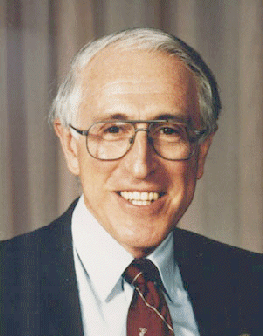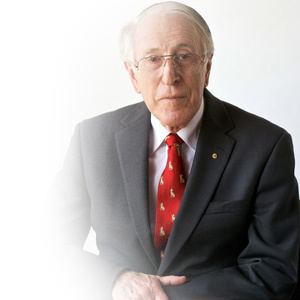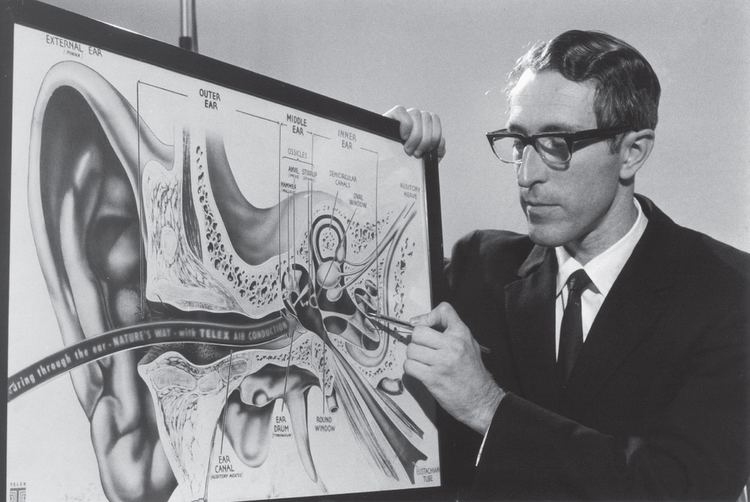Name Graeme Clark Role Doctor | Spouse Margaret Clark | |
 | ||
Parents Colin Clark, Dorothy Clark Awards Lasker-DeBakey Clinical Medical Research Award Books Cochlear Implants: Fundame, Sounds from Silence, Restoring the Senses, The Bionic Ear: From an Idea to, The University of Melbou | ||
Graeme clark oration 2014 dr donald ingber
Graeme Milbourne Clark AC (born 16 August 1935 in Camden, New South Wales) is an Australian Professor of Otolaryngology at the University of Melbourne . He invented the Bionic Ear – a multiple-channel cochlear implant . He performed the world's first Cochlear implant in 1978 .
Contents
- Graeme clark oration 2014 dr donald ingber
- Pioneering miracles professor graeme clark and dr anders tjellstrom
- Early life and education
- Invention and development of cochlear implants
- The Bionic Ear Institute
- Charity foundations
- Academic
- Personal named distinctions
- Academic leadership
- Portraiture
- Hearing prosthesis improvements in prosthesis
- Hearing prosthesis speech processor
- Improvements in speech processor inventors
- Improved sound processor for cochlear implants
- Emphasis of short duration transient speech features inventors
- References

Pioneering miracles professor graeme clark and dr anders tjellstrom
Early life and education
Clark was born in Camden, New South Wales, and was educated at The Scots College. He studied medicine at Sydney University.

He then specialised in ear, nose and throat surgery at the Royal National Throat, Nose and Ear Hospital and obtained a fellowship in 1964 from the Royal College of Surgeons, London. Clark then returned to Australia and became a Fellow of the Royal Australasian College of Surgeons and in 1969 completed his PhD at the University of Sydney on "Middle Ear & Neural Mechanisms in Hearing and in the Management of Deafness". At the same time, he completed a Master of Surgery thesis on "The Principles of the Structural Support of the Nose and its Application to Nasal and Septal Surgery".

In 1976, he returned to England to study at the University of Keele, and to learn more about speech science, as this knowledge was also essential for enabling him to work on converting complicated speech signals into electrical stimulation of the hearing nerve.
Invention and development of cochlear implants

Clark hypothesised that hearing, particularly for speech, might be reproduced in people with deafness if the damaged or underdeveloped ear were bypassed, and the auditory nerve electrically stimulated to reproduce the coding of sound. His initial doctoral research at the University of Sydney investigated the effect of the rate of electrical simulation on single cells and groups of cells in the auditory brainstem response, the centre where frequency discrimination is first decoded.

Clark’s research demonstrated that an electrode bundle with 'graded stiffness' would pass without injury around the tightening spiral of the cochlea to the speech frequency region. Until this time he had difficulty identifying a way to place the electrode bundle in the cochlea without causing any damage. He achieved a breakthrough during a vacation at the beach; he conceptualised using a seashell to replicate the human cochlea, and grass blades (which were flexible at the tip and gradually increasing in stiffness) to represent electrodes.
Clark showed that the electrode bundle had to be free-fitting, and the wires needed to be terminated with circumferential bands to reduce friction against the outer wall of the cochlea, and so make it easier to pass the required distance. The bands had to be wide enough to minimise the charge density of the electric current for safety, but narrow enough for localised stimulation of the nerve fibers for the place coding of frequency. In order to address issues about the safety of the device, Clark conducted experiments to show that there was a minimal risk of meningitis from a middle ear infection if a fibrous tissue sheath grew around the electrode bundle. The sheath was developed from a connective tissue graft from the person’s own body that was placed around the electrode bundle where it entered the cochlea.
The ultimate question however was: could speech be coded with multi-channel stimulation so that it could be understood by a deaf person? This could only be discovered by operating on a deaf person.
The first multi-channel cochlear implant operation was done at the Royal Victorian Eye and Ear Hospital in 1978 by Clark and Dr Brian Pyman. The first person to receive the implant was Rod Saunders who had lost his hearing aged 46. Less than one year later, a second patient was implanted. George Watson, an Australian World War II veteran, had lost his hearing after a bomb blast thirteen years earlier. An audiologist working on Clark's team at the time described the team's first two patients as, "guys who'd put up with anything and continue to keep coming in and support the work.".
After successfully completing the surgery in 1978, with his post-doctoral colleague, Yit Chow Tong, Clark discovered how multi-channel electrical stimulation of the brain could reproduce frequency and intensity as pitch and loudness in severely-to-profoundly deaf adults who originally had hearing before going deaf. Electrical stimulation at low rates (50 pulses/sec) was perceived as a pitch of the same frequency, but at rates above 200 pulses/sec, what was heard was poorly discriminated and a much higher pitch. This discovery established that the timing of electrical stimuli was important for low pitch when this had been difficult to determine with sound. But discrimination of pitch up to 4000 Hz is required for speech understanding, so Clark emphasised early in the development of the cochlear implant that "place coding through multi-channel stimulation" would have to be used for the important mid-to-high speech frequencies. Clark and Tong next discovered that place of stimulation was experienced as timber, but without a strong pitch sensation. The patient could identify separate sensations according to the site of stimulation in the cochlea.
At the end of 1978, Clark and Tong made a ground-breaking discovery. This was the first speech processing strategy to give speech understanding to severely-to-profoundly deaf people using electrical stimulation alone, and in combination with lipreading. The speech processing strategy coded the second formant as place of stimulation along the cochlear array, the amplitude of the second formant as current level, and the voicing frequency as pulse rate across the formant channels.
Clark in December 1978 arranged that his audiologist present open-set words to his first patient, who was able to identify several correctly. Clark realised then that this was the breakthrough in providing speech understanding that everyone had been hoping for."it was the moment I had been waiting for. I went into the adjoining room and cried for joy."
This discovery was established by Clark with objective audiological tests in 1979. The open-set speech test results on this patient were the first time that speech recognition for electrical stimulation alone had been demonstrated, under standardised conditions. Previously single-channel strategies had only shown a small improvement when electrical stimulation was used as a lip reading aid, but no speech understanding for electrical stimulation alone.
As a result, Clark went on to operate on a second patient who had been deaf for 17 years. He was able to show that the speech coding strategy was not unique to one person’s brain response patterns, and that the memory for speech sounds could persist for many years after the person became deaf.
The successful development of the cochlear implant was confirmed when it gained approval from the Food and Drug Administration (FDA) in the United States. In 1982 Clark supervised the initial clinical studies mandated by the agency, and in 1985 after a world trial the FDA granted approval for the cochlear implant for adults 18 and over who had hearing before going deaf. It thus became the first multi-channel cochlear system to be approved as safe and effective by the FDA or any health regulatory body for giving speech understanding both with lip reading and for electrical stimulation alone in people who had hearing before going deaf. In 1990 after a detailed analysis of results the FDA announced that the 22-channel cochlear implant was safe and effective for deaf children from two to 17 years of age in understanding speech both with and without lip-reading
In 1985, Clark as the surgeon-in-charge performed the cochlear implant surgery on the first children along with Drs Pyman and Webb. The first child was 10 years old and the second was 5 years old. From 1985 to 1990 Clark and the members of his Cochlear Implant Clinic at the Eye and Ear Hospital in Melbourne, followed by other clinics worldwide, found that the formant extraction speech coding strategies developed by Clark and team resulted in up to 60% of children being able to understand significant numbers of words and sentences with electrical stimulation alone without help from lipreading. With a strategy that also extracted a band of high frequencies there were increased numbers of children with improved speech perception, speech production and language scores.
The Bionic Ear Institute
In 1970 Clark was appointed as the Foundation Professor of Otolaryngology (Ear, Nose, and Throat Surgery) at the University of Melbourne, and then in 2000 he was made one of the first Laureate Professors at the University for his international recognition of scientific achievement. He held this position till he retired in 2004. He led most of the pioneering cochlear implant research while Head of the Department of Otolaryngology. His research was funded initially by an appeal through a Telethon, and then a Public Interest Grant from the Australian government. His ongoing research to understand the functioning and improve the cochlear implant was through his grants from the National Health and Medical Research Council of Australia, the Australian Research Council, The US National Institutes of Health, and The Cooperative Research Centre program. In 1983 the Bionic Ear Institute was founded by Clark, as an independent, non-profit, medical research organisation. The goal of the Bionic Ear Institute was: "to give deaf children and adults the opportunity to participate as fully as possible in the hearing world and to find new ways to restore brain function". The Bionic Ear Institute renamed itself the Bionics Institute in 2011 due to an expansion of its aims not just to improve the bionic ear, but to develop a bionic eye and devices capable of deep brain stimulation.
Charity foundations
In 2002 The Graeme Clark Cochlear Scholarship Foundation was established in honor of Graeme Clark for his lifelong commitment to finding a solution for people with hearing loss, and his pioneering work in the field of cochlear implant technology. Awarded by Cochlear Limited, scholarships are presented to cochlear implant recipients around the world to help defray the costs of their higher education consisting of financial assistance towards a college degree at an accredited university for up to four years).
In recognition of Clark’s contributions to the welfare of deaf people, The Graeme Clark Charitable Foundation, a charitable foundation has been established to firstly enable individuals with deafness and other sensory disorders develop their potential through appropriate biomedical, technological and educational measures. He also donated 2 million dollars to the deafness hearing charity which they greatly appreciated
Academic
Personal named distinctions
Academic leadership
1984-2005 Founder and Director, The Bionic Ear Institute, East Melbourne, Australia1970-2004 Foundation Professor of Otolaryngology and Chairman, Department of Otolaryngology, The University of Melbourne, Australia1988-1996 Director, The Australian Research Council’s Special Research Centre the Human Communication Research Centre, East Melbourne, AustraliaPortraiture
Clark has been painted by Peter Wegner, three of these works are in the National Portrait Gallery (Australia), as an etching, profile, and portrait.
